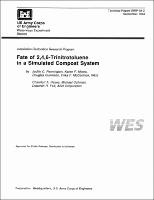Please use this identifier to cite or link to this item:
https://hdl.handle.net/11681/4810| Title: | Fate of 2,4,6-Trinitrotoluene in a simulated compost system |
| Authors: | Installation Restoration Research Program (U.S.) Pennington, Judith C. Hayes, Charolett A. Myers, Karen F. Gunnison, Douglas Felt, Deborah R. McCormick, Erika F. Ochman, Michael |
| Keywords: | Composting Explosives TNT Soil pollution Humification |
| Publisher: | Environmental Laboratory (U.S.) Engineer Research and Development Center (U.S.) |
| Description: | Technical Report Abstract: Composting of explosives contaminated soils is an economical alternative to other available treatment technologies. Development of a protocol for treatability studies in this work unit required mass balance of 2,4,6-trinitrotoluene (TNT) in the composting process to determine whether environmentally undesirable emissions or residuals are produced. The objective of the study was to develop methods for determining mass balance of TNT in a small-scale (473-m³) compost system. Results of the three small-scale experiments indicated that composting could be simulated at the small scale and that a mass balance for TNT could be determined under mesophilic conditions. Mass balance indicated no significant losses of TNT or its transformation products from the compost as volatile organic compounds or carbon dioxide. No solvent extractable TNT or its transformation products were found. Almost all (70 to 95 percent) of the radioactivity remained in the compost. The fourth small-scale experiment was designed to simulate thermophilic conditions using an uncontaminated soil; the fifth investigated the effects of reducing microbial activity on the fate of TNT in the compost matrix; and the sixth simulated thermophilic conditions in a contaminated soil from Umatilla Army Depot Activity, Umatilla, OR. The composted material was subjected to a fractionation procedure to determine where in the final matrix the TNT or its transformation products remained. Results of these experiments indicated that thermophilic conditions could be simulated at the small scale, once key operational conditions were optimized. Fractionation studies indicated that more than half of the radioactivity from added radiolabeled TNT was recovered in the cellulose and humin fractions. The chemical composition and long-term stability of the explosives/cellulose and the explosives/humin matrices resulting from comporting of explosives-contaminated soils is unknown. Furthermore, the environmental safety of decomposition products released over the long-term when these matrices ultimately decompose are currently undefined. |
| Rights: | Approved for public release; distribution is unlimited. |
| URI: | http://hdl.handle.net/11681/4810 |
| Appears in Collections: | Technical Report |
